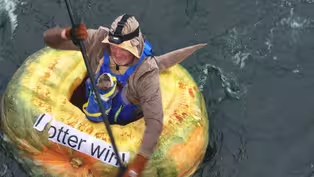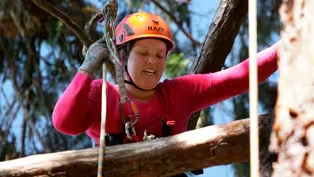Oregon Field Guide
Salt Makers
Clip: Season 35 Episode 6 | 8m 47sVideo has Closed Captions
How salt is made along the Oregon Coast.
The legacy of salt making is explored, from the days of Lewis and Clark to the modern salt-making facilities of Jacobsen Salt Company.
Problems playing video? | Closed Captioning Feedback
Problems playing video? | Closed Captioning Feedback
Oregon Field Guide is a local public television program presented by OPB
Oregon Field Guide
Salt Makers
Clip: Season 35 Episode 6 | 8m 47sVideo has Closed Captions
The legacy of salt making is explored, from the days of Lewis and Clark to the modern salt-making facilities of Jacobsen Salt Company.
Problems playing video? | Closed Captioning Feedback
How to Watch Oregon Field Guide
Oregon Field Guide is available to stream on pbs.org and the free PBS App, available on iPhone, Apple TV, Android TV, Android smartphones, Amazon Fire TV, Amazon Fire Tablet, Roku, Samsung Smart TV, and Vizio.
Providing Support for PBS.org
Learn Moreabout PBS online sponsorship(waves distantly crashing) - [Narrator] In 1805, the Lewis and Clark Expedition reached the Oregon Coast.
- [Reenactor] Just after Christmas in 1805, Captain Lewis decided that they needed to get more salt.
They were running out, and the only place he could get it would be the ocean.
(gentle music) So they came down here and they started making salt.
- [Narrator] Every year, members of the Pacific Northwest Living Historians get together at Seaside to reenact the original making of salt by the Lewis and Clark Expedition's Corps of Discovery.
- Well, most people would figure, and which I did, was, well, you get seawater and you boil it down, and then you get salt from it, right?
And that is what we're doing.
But it turns out that there are more processes that you need to go through in order to really get what you want.
(lively folk music) (blade scraping) (fire crackling) (worker chuckles) - [Narrator] Meanwhile, some 50 miles down the Oregon Coast to the south, another group is working hard to make salt from Pacific seawater.
The team at Jacobsen Salt Company are moving the process into the future, and both groups are using their ingenuity to take water out of the ocean and convert it into pure, clean, edible salt.
(lively folk music) The quality of salt starts at the source.
The estuary of Netarts Bay is an ideal environment for salt-making.
As the tide rises, it sweeps over beds of oysters, some of nature's original water filters.
Every morning, Jason, the operations manager, takes his morning coffee to check on the intake pipe.
- This right here is our intake.
This is where all the salt comes.
This is where the process begins, and we'll wait 'til it's slack tide, where everything is sort of settled down, and then we'll pump for a few hours, but this is where it all starts.
- [Narrator] At the peak of the tide, the water is pumped into holding tanks.
Then it is processed through reverse osmosis.
Reverse osmosis is a water filtration process commonly used to separate salt from water, also known as desalinization, but in this case, they reconfigure the flow, separating out the fresh water as the byproduct to leave even saltier water.
- Lewis and Clark would freak out if they could see this.
If they could time travel, their minds would be blown, and it's pretty cool that we're doing it in Oregon, like they did.
(birds squawking) - [Narrator] Captain Lewis noted in his journal that the men dispatched to the salt camp returned with excellent, fine, strong, and white salt, but without detailed historic records of how the original Corps of Discovery made salt, for the reenactors, it's trial and error.
- Uh-oh.
First times we tried this, we had gray salt.
I mean, it was gray and green, because the copper kettles that we have leached the green from the copper.
- That was one of the things that we learned in the last couple of years, that cleaning the kettles is always a good thing.
- Ah!
We're still perfecting our methods.
We've gotten it a lot better.
It's not as green as it used to be.
(Mark chuckles) - Also, we started straining it through a cloth, but I felt like an idiot.
'cause when I was a kid and we milked the cows, we would strain the milk through a cloth.
It's like, well, why didn't I think of that?
- We're aiming to get it as beautiful and pure white as the Jacobsen Company does with their methods, but we haven't got there yet.
- [Narrator] Back at Jacobsen's, Tim, the lead salt-maker, checks the salinity as the water boils off.
When the brine is good and strong, he moves it to the next step, heated tables.
- This is our evaporator room.
This is where the magic happens.
So, right now, this is about ready to be harvested.
What's going on here?
There's a slow thermal current that's active right now, and this helps our salt flakes form.
- [Narrator] The ocean water that had started at about 3% salinity is now somewhere around 28%, the point when salt crystals begin to form.
- Small crystals will start forming together to create a large pyramid-like structure.
It is forming upside down at the surface, and just when the surface tension can't hold it, it starts essentially snowing into the pan.
- [Tim] A lot of it's all eyes.
What are you looking at?
What are you seeing?
Is it time to harvest?
Oh, it looks like it's time to harvest.
Okay, I'm gonna harvest, you know?
- [Narrator] After harvesting, the salt is rinsed in the barrels.
This removes the traces of brine, as well as helps clean away calcium and magnesium.
The clean, wet salt must then be dried.
They load trays into a specially modified shipping container that they can heat up to about 140 degrees.
- And then we get this.
This is almost dry, so this is pretty much what it looks like before it's sorted.
That's the next step.
- [Narrator] Amanda's roots on the Oregon Coast goes several generations back.
She's the lead of post-production, the step where the salt is inspected and sifted by size.
- I kind of like the way it looks coming out of the spout.
It's almost like it's in slow motion.
I do love it.
Nobody else is doing anything like this anywhere, so it's like a craft, almost like an art.
- [Narrator] It takes about two weeks for the Jacobsen team to make salt from bay to bag, as they say, but the reenactors have just the two-day weekend.
They keep the fires burning through the night, just like the original Corps of Discovery.
(gentle music) - [Reenactor 1] We call this living history, and there's something extraordinary about trying to live it.
- [Reenactor 2] At the end of the day, and it starts to get dark, you can hear the ocean.
You can feel the wind.
You've got the fire light.
It's almost like you were out here in 1806.
- [Reenactor 1] I can find what must have been the feeling that the men of the original Corps of Discovery had about each other, about their crew.
(fire crackling) And, you know, poking at that fire and putting more firewood in there.
It's a part of me now.
- [Narrator] It's now the final day for the reenactors.
Mark checks on the salt.
It looks like it's about time to harvest the contents of their kettle, which has become a slurry, kind of like a porridge.
- [Reenactor] It's getting hot.
- [Narrator] The slurry is drained in a canvas filter.
Then the remaining sea water is wrung out, producing, at last, the results of the weekend's work, old-fashioned sea salt, or at least as old-fashioned as the reenactors can make it.
The batch is laid on a board and spread out to dry in the sun.
The end result is not exactly the pure flakes of the modern coastal salt makers.
The techniques have become more refined, but the process is still as elemental as the salt itself.
- When I look back at, like, even Lewis and Clark to what it's come to now, it's still a primal process.
We're still using flame to heat up water.
We might change our heat source, but it's still heat to water to evaporation.
That's very primal.
I don't think that will ever change.
(water burbles) (gentle music) - Great people just doing their thing in their own northwest-y way.
We love bringing you stories like this.
Support what you love.
Opb.org/video.
Video has Closed Captions
Clip: S35 Ep6 | 3m 12s | It's a pumpkin race in Tualatin, Oregon! (3m 12s)
Video has Closed Captions
Clip: S35 Ep6 | 13m 10s | Scientists learn how to ascend and study the world’s tallest trees. (13m 10s)
Providing Support for PBS.org
Learn Moreabout PBS online sponsorshipSupport for PBS provided by:
Oregon Field Guide is a local public television program presented by OPB

















